Feb 21, 2017
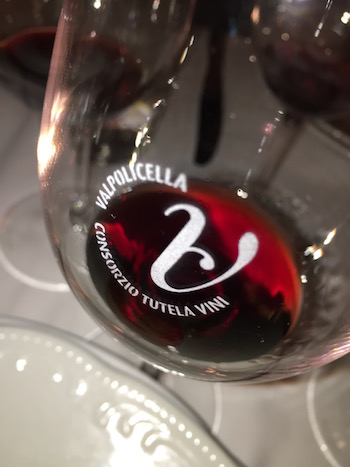 In January, the 2013 vintage Amarones were released in Verona. In January, the 2013 vintage Amarones were released in Verona.
The annual event, Antiprima Amarone, is held in the central Piazza Brá, at the Palazzo della Gran Guardia, across from the city's famed arena.
It is presented by the Valpolicella Consorzio Tutela Vini and its members.
Prior to the event, I spent three days visiting numerous producers -- large and small.
More coming on those visits.
Show Valpo Some Love
While Amarone seems to have a fierce grip on the world's palates, the quintessential Valpolicella, appears to be struggling.
Something I found frustrating.
Your everyday Valpolicellas really deserve more love.
They are perfect daily table wines with a fresh and modest character, which are made from the same varieties as Amarone.
Valpolicella Regional Overview
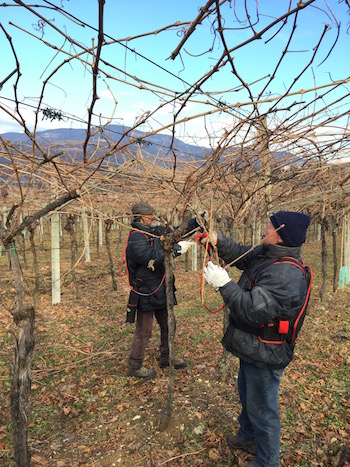 Currently, Italy has some 504 different cultivated varieties. Of those, 124 have been discovered in the past 11 years. Currently, Italy has some 504 different cultivated varieties. Of those, 124 have been discovered in the past 11 years.
There are 278 black (red) varieties, 215 white varieties, one grey, and 10 pink varieties.
Of the 504, a small handful find themselves sown in the Verona zone.
FYI, within the Verona zone, you also have Soave, Lugana and Bardolino - but for now, we talk only of Valpolicella.
In the Valpolicella Denominazione di Origin Controllata (DOC) there are four wines: Valpolicella, Amarone, Recioto and Ripasso. These wines are made using the red varieties that respond best to drying; Corvina, Corvinone and Rondinella, and to a lesser extent Molinara (no longer a mandatory blender), Oseleta, and Spigamonti (a new autochthonous variety discovered in Negrar, which responds well to the drying process required for Amarone and Ripasso).
Photo right: pruning trellis vines at Salvaterra
Photo below right: drying grapes at Valentina Cubi
Amarone and Recioto are made from select grapes harvested and then dried (typically on trays). While Amarone are left to ferment dry (during the alcoholic fermentation), the fermentation of Recioto wines is halted, so the sugars are not all consumed. This results in a thick and sweet dessert wine, which today, struggles mightily in sales.
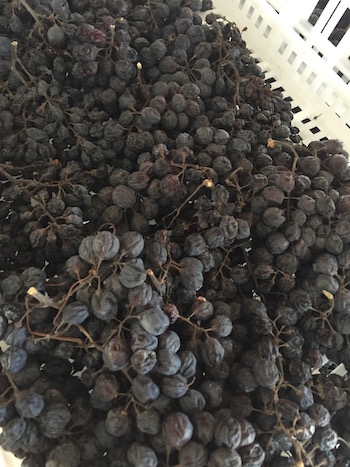
Amarone, while having been made in one manifestation or another in the region for centuries, made a comeback in the 1950s and only gained true international popularity in the late part of the 20th century.
Valpolicella's Amarone, gained its Denominazione di Origin Controllata Guarantita (DOCG) status in 2009.
Despite its overall impressive popularity, Ripasso is the most contentious (often dubbed baby Amarone) style. Regarded by professionals as a waste good Valpolicella grapes... a product made to capitalize on Amarone's success.
However you slice it, it's worked.
I'll admit, personally, I'd prefer to see more effort spent on the classic Valpo table wines, however, their sales have been in decline since 2009, so the battle is real.
In truth, Ripassos are a bit of an afterthought. Once the already dried grapes have been pressed for the sacred Amarone, and decadent Recioto wines, the leftover pressed skins (pomace) are combined with regular lighter bodied (lower-alcohol) and juicy Valpolicella wines. The skins, which still contain sugars, some tannins and flavour, begin a second fermentation of the base wine. The second ferment adds suppleness, softened tannins and the added pomace lends it richness and depth.
Ripasso (meaning: to go over, review or repass), is basically the middle-man between Amarone and Valpolicella -- don't shoot the messenger.
The Valpolicella Classico wines come from a demarcated zone within Valpolicella, the original zone, before it was expanded in 1968.
Valpolicella Superiore must have been aged one year, and have a minimum alcohol content of 12%. Therefore, a Valpolicella Classico Superiore is a traditional Valpolicella blend from within the DOC zone and is aged at least one year with a minimum of 12% alcohol.
Got it?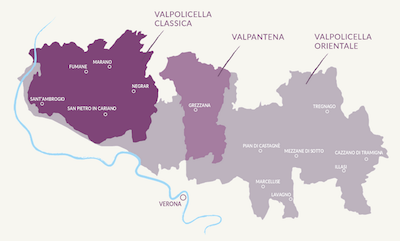
Within the region there five geographically different subregions -- of unique biodiversity and topography, with stunning, undulating and multiple aspect hillside vineyards, as well as valley basin growing sites.
Those regions (see map at right) within the Classico zone are Sant'Ambrigio di Valpolicella, San Pietro in Cariano Valley, Fumane, Marano and Negrar Valley.
Valpatena Valley sits separately, east of the Classico region.
The DOC zone includes part of northern Verona, Illisa, and the Tramigna and Mezzane Valleys.
The region begins east of Lake Garda and stretches toward the coast (map below), part way to Venice.
The cooling temperatures of the lake regulate the vineyards in closest proximity, supplying cooler days but also less fluctuation of day to night temperatures.
The outer valleys provide warmer days but also cooler nights.
Additionally, you will see more traditional (pergola Veronese) vine plantings in the region than elsewhere -- the majority still (or has returned to) favours these overhead trellises, and the remainder are guyot.
Overall, the soils tend toward limestone and calcareous with pockets and clay and marl. There are a few small pockets of volcanic soils.
*Map above right courtesy of Valpolicella Consorzio
*Map below right, courtesy of amaronetours.it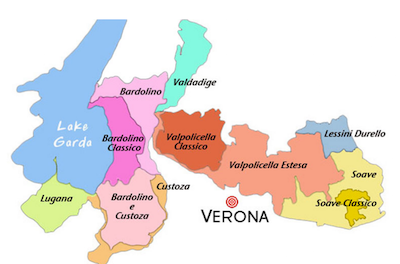
Antiprima Amarone 2013
I tasted roughly 40 recently bottled vintage 2013 Amarones.
The 2013 vintage started out quite rough with heavy rain through May, which played havoc with the temperatures and ripening. Then in June, the sun came out and heat soared through to the end of August before leveling off. The extremes of the season seemed to be have been balanced.
My Top Picks
Bennati Amarone Della Valpolicella, 2013
Sweet black cherries, fertile earth, tobacco, bittersweet chocolate and toasted spices with cedar and violet undertones. Expect a sweet and powerful entry; it is concentrated and elongated and quite firm across the palate. Wonderfully consistent entry through finish. Generous fruit and vanilla flavours with supple, ripe tannins. Outstanding.
Ca’ Botta Amarone Della Valpolicella, 2013
Sweet oak aromas lead, along with graphite, hints of small red berries, and dried flowers. Lovely glycerol weight on entry with definite vanillin oak flavours contact Excellent, but slightly hot.
Stephano Accordini Amarone Della Valpolicella Classico ‘Acinatico’, 2013
The nose is predominantly earthy; pipe tobacco and toasted carrot tops with sweet red cherry hiding coyly underneath. Plate has a generous and fruity entry; fine sweet spice, leather, chocolate and mocha flavours deliver. Modern, but the oak is nicely balanced with the fruit, although a little more age should show better integration.
Corte Figaretto Amarone Dela Valpolicella Valpatena ‘Graal', 2013
Fragrant aromas of cedar chips, dried violets and spice – think botanical, rather than fruity aromas. The palate elbows its way in with sweet cherry and baking spices, vanilla, mocha and fine oak flavours. Good balance overall with ripe and sweet tannins. Elegant
Ca’ La Bionda Amarone Della Valpolicella Classico ’Vigneti di Ravazzol’, 2013
Tobacco and herbal notes, fine spice and cherry. Palate is slick and weighted, quite direct sweet fruit, cedar and dry tobacco tannins. All in – doesn’t seem to be trying to be something it isn’t. True, honest wine. Sweet ripe tannins.
Roccolo Grassi Amarone Della Valpolicella, 2013
Crowd pleasing maraschino cherry notes alongside vanilla, baking spices, hot nose, chocolaty and sweet, verymodern nose, very attractive with cut purple flowers as well. Equally sweet and glyverol, liqueur-like and boozy, menthol and spice. A cigar and chocolate cake Amarone.
Tinazzi Amarone Della Valpolicella’ ‘Ca de Roccchi – La Bastia’, 2013
Sweet vanillin oak, baking spices, preserved oranges, cherry and wild forest berries – bordering on blackberry -- with crushed violet undertones. It is spicy, vanillin, sweetly ripe and chocolaty. Generous fruit balances oak, which adds a potent and lengthy ambrosial finish to the final wine. A well made, modern crowd-pleaser.
The following wines ran a close second.
Cantina Valpatena Verona Amarone della Valpolicella, 2013
Expect attractive aromas of sweet ripe fruit, cherries and juicy purple berries with vanilla, spice and pipe tobacco. The palate offers liberal fruit and an attractive spice character. Sweet glycerol weight, but not heavy -- an attractive modern style with a slick texture. The finish is long warm with chewy tannins.
Degani Amarone Della Valpolicella Classico ‘La Rosta’, 2013
Expect oodles of potent sweet cherry aromas with vanilla, black raspberry and baking spices. It delivers loads of fruit to the palate alongside oak spice and vanillin. Generous, with ripe tannins, good balance and commendable persistence and weight.
La Giuva Amarone Della Valpolicella, 2013
The nose is distinctly oxidative compared to its peers – think dried cherries and molasses. The palate, while more generous than expected, is still a leaner style – Its charming freshness and juiciness is very appealing. A finer boned, and elegant wine, overall.
Villa Mattielli Amarone Della Valpolicella, 2013
On the nose, oak spice and vanilla, charred orange peel and preserved cherries. It has a slick entry, and somewhat bruised and dried fruit on the palate. Seems to be quite mature with nice tapered sweet finish with ripe tannins – seems more likely to be aged in botte. Slightly bitter classic coffee and herbal finish – it has a bright lifted finish.
Domeni Veneti Amarone della Valpolicella Classico, 2013
A nose of mineral, dried red berries, preserved cherry and bruised oranges along with spicy, vanillin oak. Palate shows that spicy and sweet vanillin oak equally, yet the fruit is opulent and attractive overall. Undoubtedly a more modern, populous style, sweet, spicy with a warm finish.
Pasqua Vigneti e Cantine Amarone della Valpolicella Classico ‘Villa Borghetti’, 2013
Restrained nose with tobacco, dried plum fruit. A conflicting entry is attractive, starting with generous fruit, but than abruptly leans into tobacco, fine spice, vanilla and bitter orange. Good balance overall, nice tannins from skins. It offers sweet vanillin oak atop herbal flavours. Palate is spicy and sweet, layered with espresso, mocha and plenty of preserved cherries. Weighty and slick, a generous and consistent weight entry to finish, and the tannins are fine.
~Daenna Van Mulligen
|


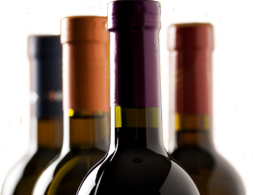

 In January, the 2013 vintage Amarones were released in Verona.
In January, the 2013 vintage Amarones were released in Verona. Currently, Italy has some 504 different cultivated varieties. Of those, 124 have been discovered in the past 11 years.
Currently, Italy has some 504 different cultivated varieties. Of those, 124 have been discovered in the past 11 years.


